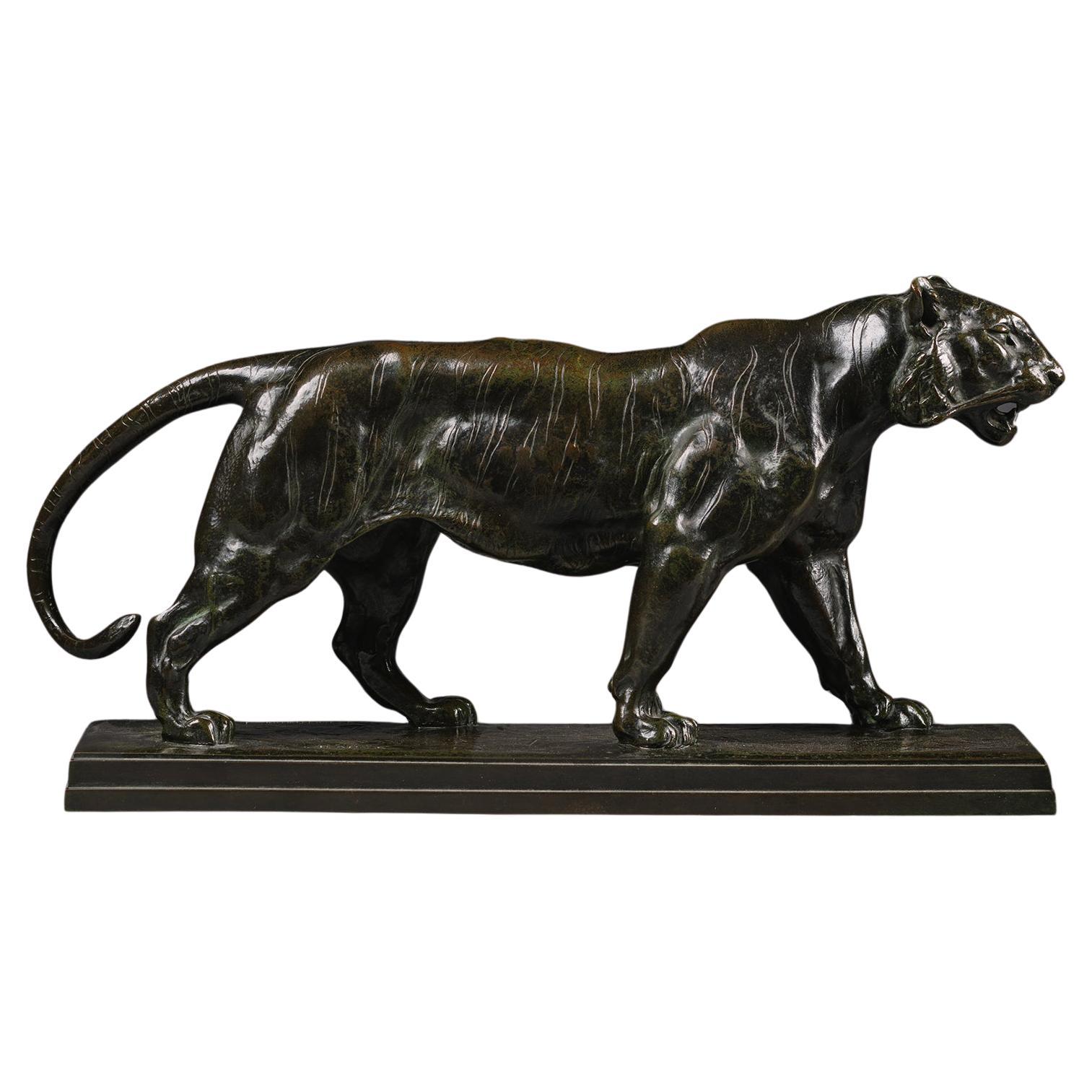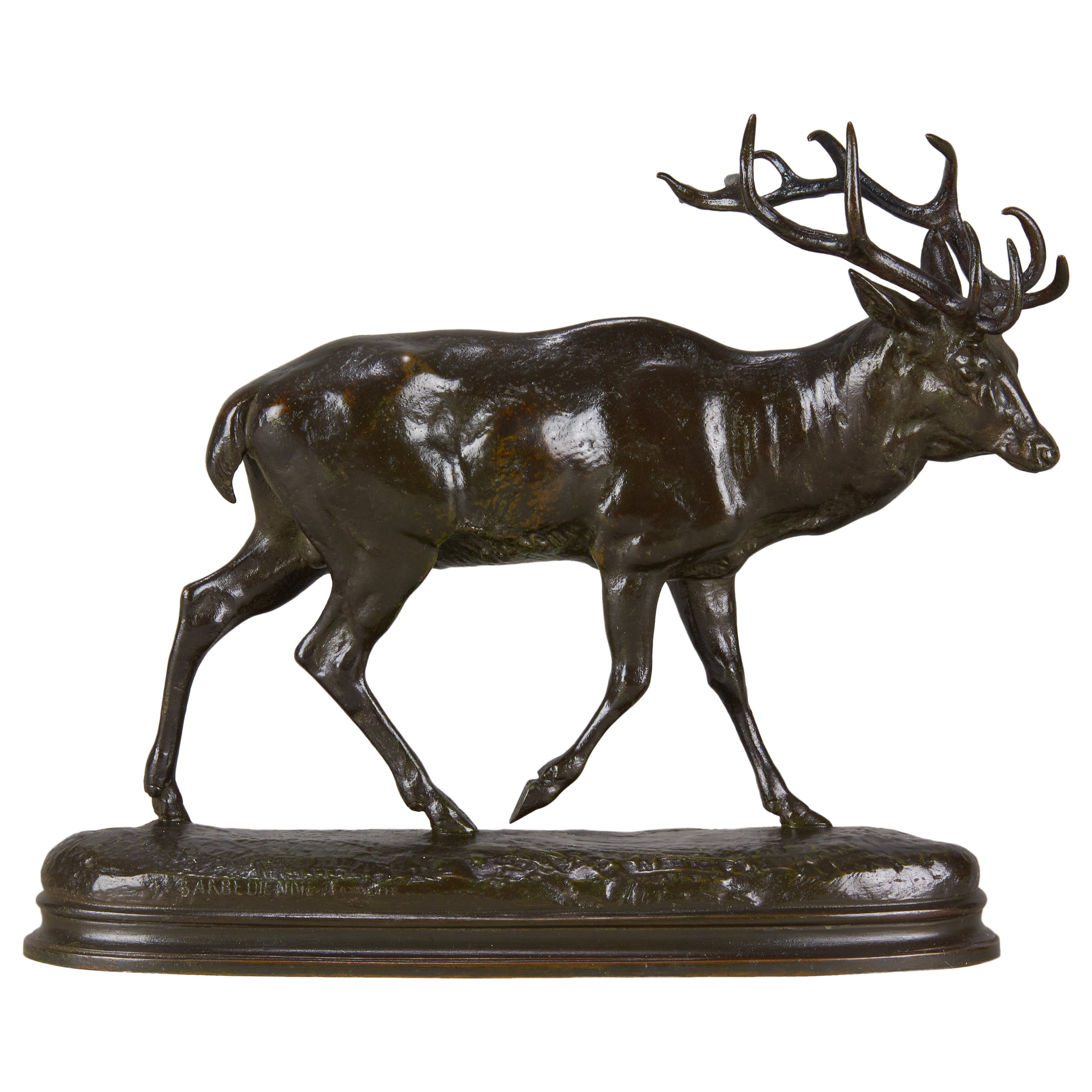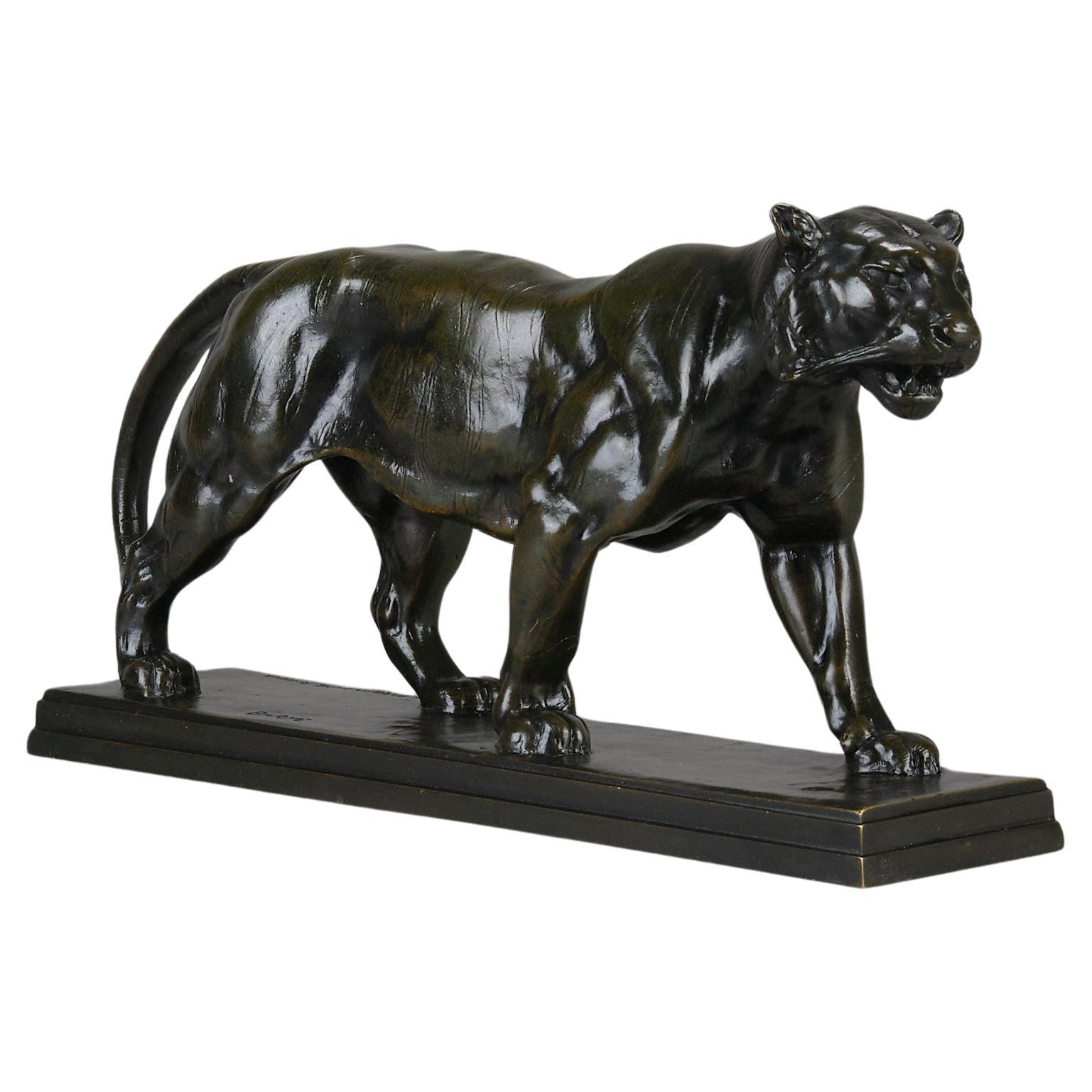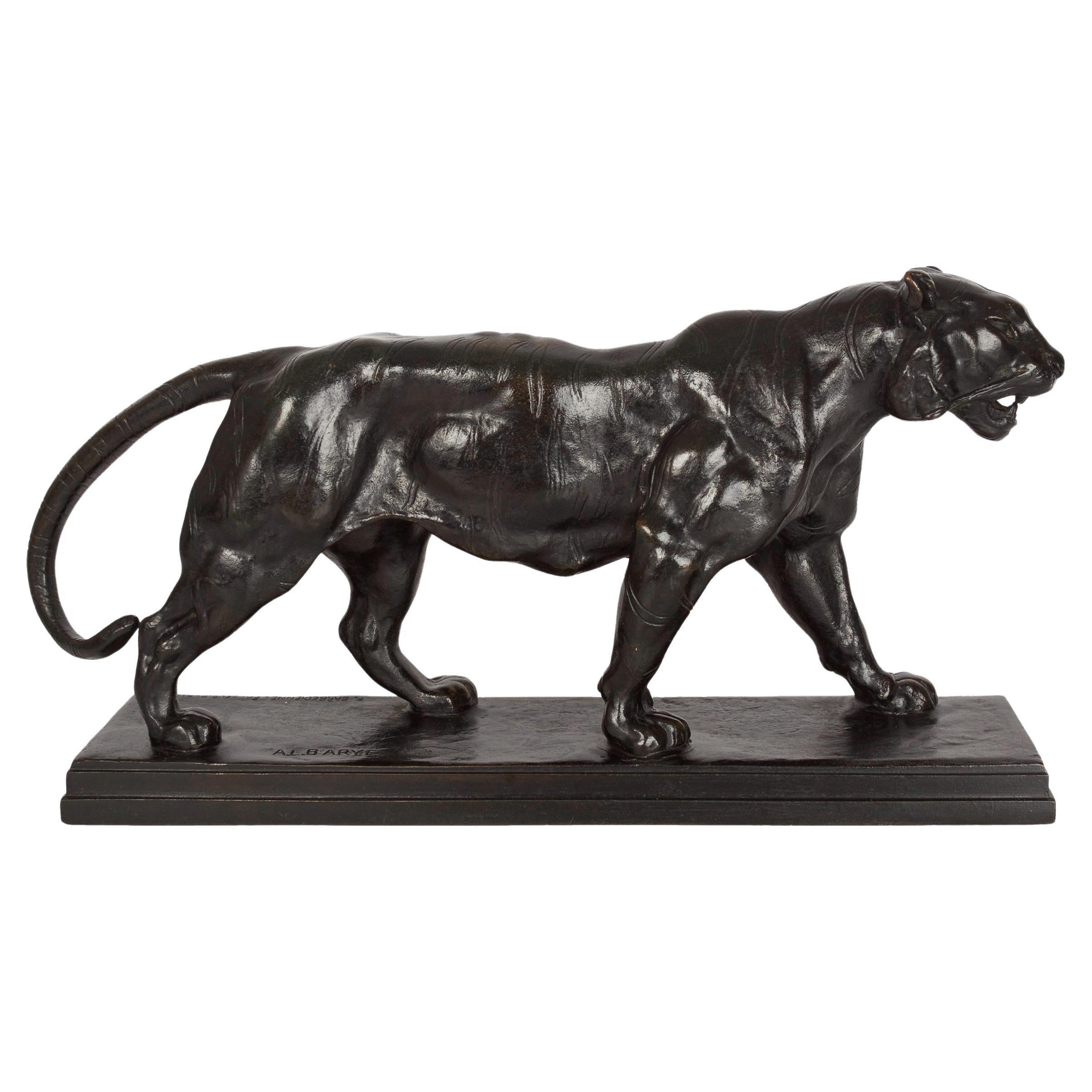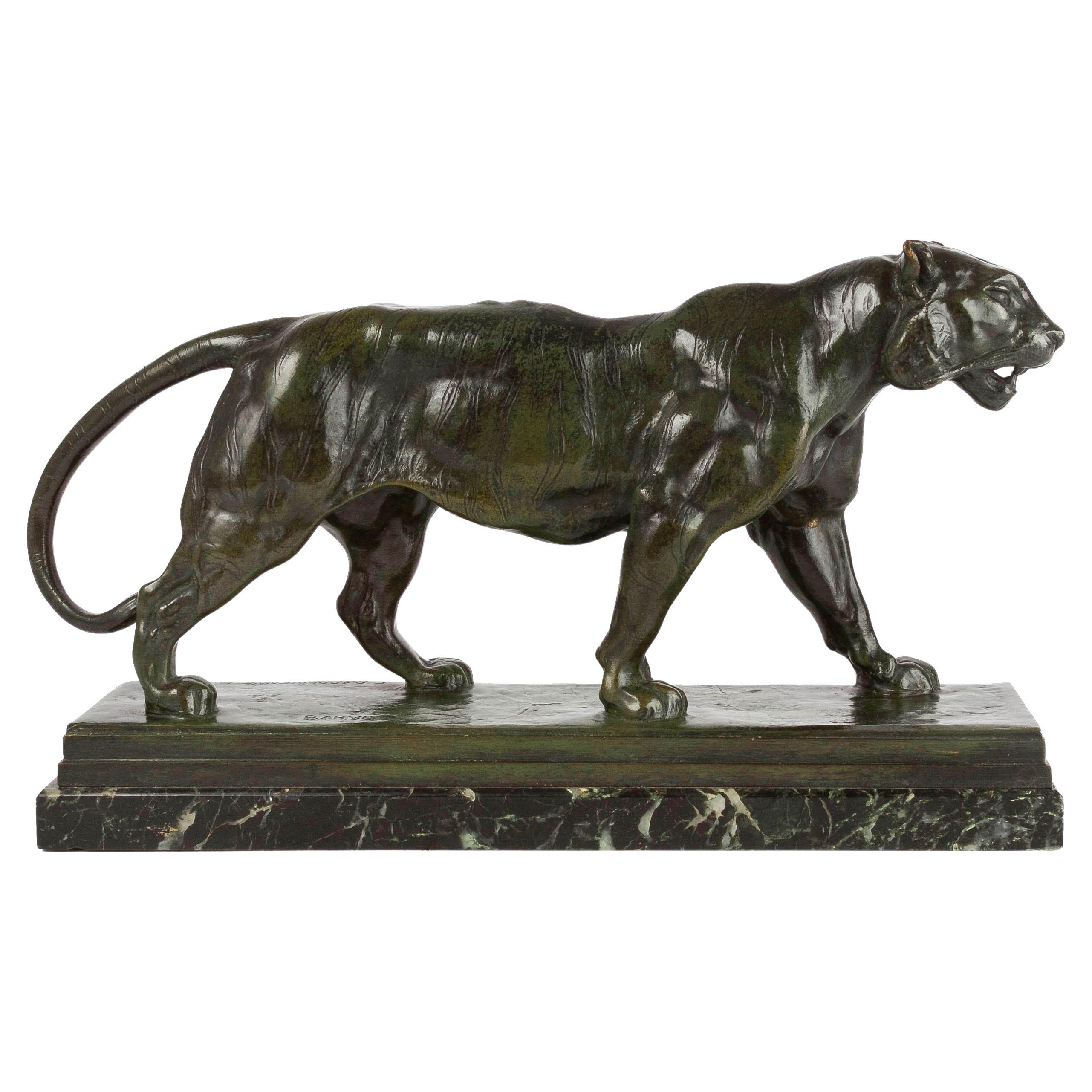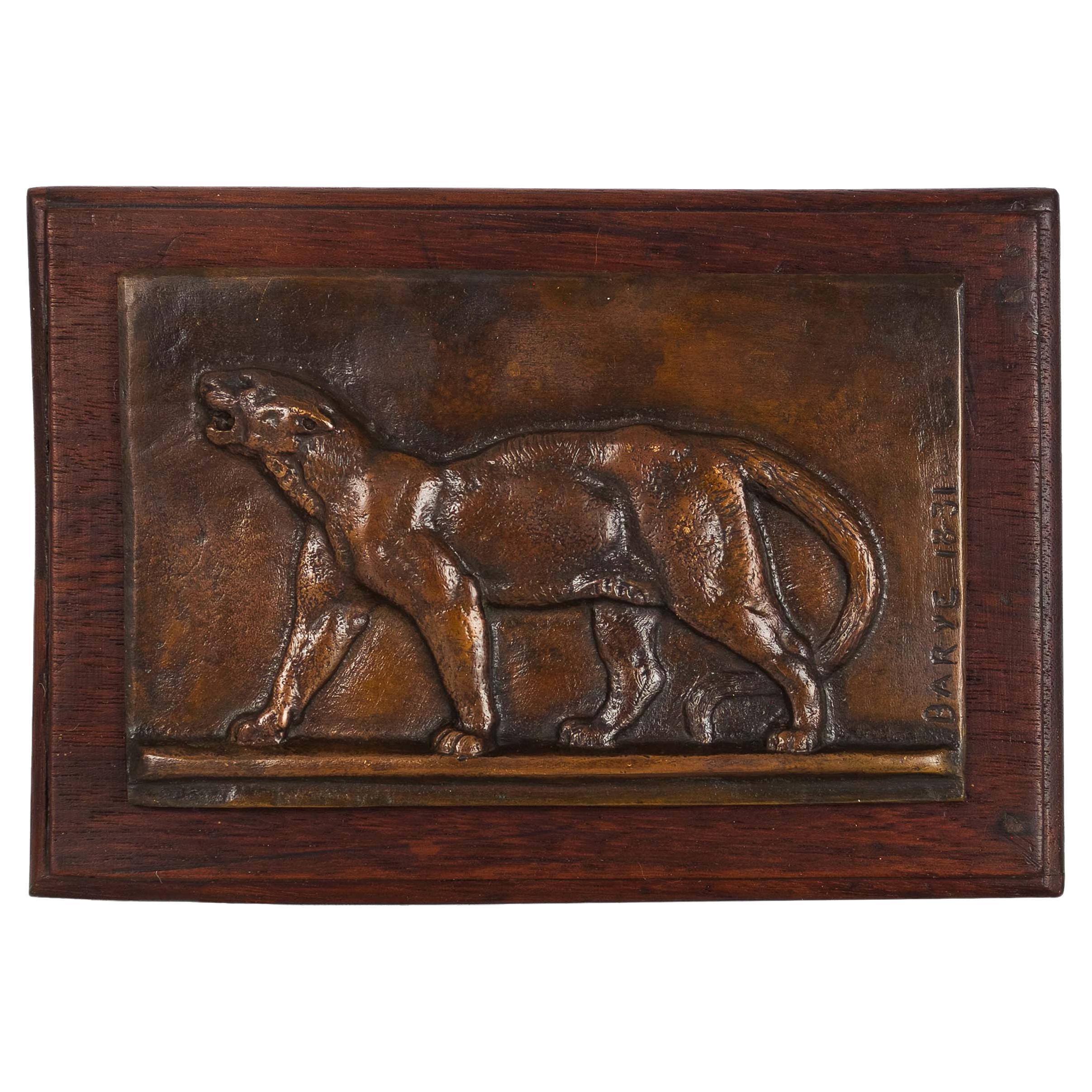Items Similar to Jaguar Qui Marche No. 2 (Walking Jaguar) Antoine L Barye
Want more images or videos?
Request additional images or videos from the seller
1 of 11
Jaguar Qui Marche No. 2 (Walking Jaguar) Antoine L Barye
About the Item
From our Sculpture collection, we are delighted to offer this Jaguar Qui Marche No. 2 (Walking Jaguar) Bronze by Antoine-Louis Barye. The Jaguar Qui Marche translates directly to Jaguar that walks is an infamous bronze by the renowned French sculptor Antoine-Louis Barye. It is exceptionally cast upon a double stepped plinth with a dark brown and mottled green patination throughout. Signed across the base Barye and numbered to the underside ’43’, the sculpture dates to the first half of the 19th century circa 1840. This figure was originally modelled by Antoine Louis Barye (1795-1875) as a pair to a Jaguar Standing. More than a decade later he modelled a slightly different pair, also of a jaguar walking paired with a jaguar standing but this time with their ears set back and on a rocky base. It is important to note that later models typically bear the Barbedienne foundry mark due to Barbedienne purchasing the original drawings when Barye died.
Reference The same Barye figure can be seen in the V&A museum accession number A.24-1971.
-See Poletti, Michel and Richarme, Alain. Barye : Catalogue Raisonné des Sculptures Paris (Gallimard) 2000. Cat. no A90
-Animals in Bronze by Christopher Payne page 134
-Pivar, Stuart, The Barye Bronzes, A Catalogue Raisonné Woodbridge (The Antique Collectors Club), 1974, p.41, no A77
-Horswell, Jane, Bronze Sculpture of ‘Les Animaliers’ Reference and Price Guide, Suffolk (The Antique Collectors Club), 1971, p.80
Bronze is an alloy consisting primarily of copper with approximately 12–12.5% tin and often with the addition of other metals (including aluminium, manganese, nickel, or zinc) and sometimes non-metals, such as phosphorus, or metalloids such as arsenic or silicon depending on the age of the bronze and its origin. The additions of other metals produce a range of alloys that are usually harder than copper alone and carry useful properties such as strength. The earliest known use of bronze dates to the 5th millennium BCE from Iranian plateau, the bronze mix consists of arsenical copper and copper-arsenide. The earliest tin-copper-alloy recovered is dated to circa 4650 BCE and was found in Plocnik, Serbia. It is believed to have been smelted from a natural tin-copper ore.
Antoine-Louis Barye was born in Paris in 1795 and was thought to have lived his entire life in Paris and never left France throughout his life. He was a self tought in the liberal arts and initially trained under his father a goldsmith in Lyon. He went onto train with Martin-Guillaume Biennais (active 1800-1832) master goldsmith to Napoleon, fine arts sculptor François-Joseph Bosio (1768-1845) and painter Baron Gros (1771-1835). Throughout his career Barye won a host of awards and made multiple commissions for the French government. Barye was the leading sculptor in the French group of artists known as Les Animaliers and a leading sculptor in France throughout his career. Barye passed away in 1875, and after an elaborate funeral to signal his high artistic stature Barye was buried at Père-Lachaise Cemetery in Paris.
Measurements (centimetres) 11cm High x 22cm Long x 7cm Wide
- Creator:Antoine-Louis Barye (Maker)
- Dimensions:Height: 4.33 in (11 cm)Width: 2.76 in (7.02 cm)Depth: 8.66 in (22 cm)
- Style:Louis Philippe (Of the Period)
- Materials and Techniques:Bronze,Cast
- Place of Origin:
- Period:
- Date of Manufacture:Circa 1840
- Condition:Wear consistent with age and use.
- Seller Location:Newark, GB
- Reference Number:
About the Seller
5.0
Vetted Seller
These experienced sellers undergo a comprehensive evaluation by our team of in-house experts.
Established in 2019
1stDibs seller since 2022
17 sales on 1stDibs
Typical response time: 3 hours
- ShippingRetrieving quote...Ships From: Newark, United Kingdom
- Return PolicyA return for this item may be initiated within 14 days of delivery.
More From This SellerView All
- Austrian Cold Painted Bronze Horse Franz Bergman (Att.)By Franz Xaver Bergman (Bergmann)Located in Newark, EnglandBig Brown Stallion upon a onyx plinth From our Sculpture collection, we are delighted to offer this Austrian Cold Painted Bronze Horse. The Bronze mounted upon a squared green onyx base with a convex beading border. The horse beautifully cast with naturalistic features modelled as a big brown stallion inclusive of its brown to black hue. The horse stamped to the belly Geschutzt with the registration mark 2740. We firmly attribute the Austrian Bronze to Franz Bergman and date it to the late 19th century circa 1890. Franz Xavier Bergman (1861-1936) was the owner of a Viennese foundry who produced numerous patinated and cold-painted bronzes with a range of subjects such as oriental, erotic, and animal figures. He was probably the most famous Austrian bronze foundry who is widely recognised for smaller cold painted bronzes with an extremely good attention to detail. Signed often with a ‘B’ or Bergman and a registration mark. Geschutzt often stamped or printed it is pronounced “guess-shutst.” It is an abbreviation of the term gesetzlich geschutt which is a German phrase that translates as legally protected or in other words copywriter. It bares is a similar meaning to the English word Patented or French Depose...Category
Antique Late 19th Century Austrian Art Nouveau Animal Sculptures
MaterialsOnyx, Metal, Bronze
- French Bronze Belgian Shepherd Dog FigureLocated in Newark, EnglandFrench Bronze Circa 1905 upon a Marble Oval Base From our Sculpture collection, we are pleased to offer a French Bronze Belgian Shepherd Figure. The figure mounted upon a green marble base with a convex rim and ormolu border. The bronze cast as a large ormolu recumbent Belgian Shepherd dog with its head to one side wearing an ormolu collar. The bronze beautifully finished with a lifelike look showing its coat with individual strands and peaked ears. The Bronze dates to the turn of the 20th century circa 1905 after the evolution of the Belgian Shepherd in circa 1892. Belgian Shepherd (also known as the Belgian Malinois...Category
Early 20th Century French Art Nouveau Animal Sculptures
MaterialsMarble, Bronze, Ormolu
- French Bronze Ariadne After ClodionBy Claude Michel ClodionLocated in Newark, EnglandSigned Clodion From our Sculpture collection, we are pleased to offer this French Belle Epoque Bronze of Ariadne cast after Clodion (Claude Michel). The sculpture of fine casting and beautiful patination is sculpted as a bust of a Ariadne in nature with her hair tied up and leaves intwined in her hair. The Bronze sits upon a circular socle with a square base signed to the right hand face Clodion. The Bronze cast after the original during the neoclassical era dating to the second half of the 19th century during the Belle Epoque era (c.1970-1914) circa 1875. Clodion was the alias of Claude Michel (1738-1814) a French born sculptor working in the Rococo style, especially noted for his works in marble, bronze, & terracotta. Many of Clodion’s works feature in museum collections around the world with some of his most pivotal works including The Intoxication of Wine and The Dance of Time. Ariadne In Greek mythology was a Cretan princess and the daughter of King Minos of Crete. Ariadne was known for aiding Theseus escape the Minotaur and then being abandoned by him on the island of Naxos. There, Dionysus saw Ariadne sleeping, fell in love with her, and later married her. Many versions of the myth recount Dionysus throwing Ariadne’s jewelled crown into the sky to create a constellation, the Corona Borealis...Category
Antique Late 19th Century French Belle Époque Busts
MaterialsBronze
- Italian Carrara Marble Bust Augustus CaesarLocated in Newark, EnglandThe bust intricately carved from Italian Carrara marble with lifelike features including textured hair and shaped chest. The bust carved as Gaius Julius Caesar Augustus Octavius (lat...Category
Antique Early 18th Century Italian Renaissance Busts
MaterialsCarrara Marble
- French Strawberry Girl Bronze Figure Emile PinedoBy Émile PinedoLocated in Newark, EnglandThe unusual model bronze dating to the late 19th century cast as a patinated bronze cherub holding two large strawberries with the vine looping over the back of the cherubs neck as i...Category
Antique Late 19th Century French Belle Époque Figurative Sculptures
MaterialsMarble, Bronze, Ormolu
- Amphora Art Deco Elephant & Lion Porcelain Group, CzechoslovakiaBy AmphoraLocated in Newark, EnglandLarge Amphora porcelain figural group featuring two lionesses attacking an elephant. The figure of extraordinary size measuring 66.5cm High (26.18inches) featuring a large elephant s...Category
Early 20th Century Czech Art Deco Animal Sculptures
MaterialsCeramic, Porcelain
You May Also Like
- Antoine-Louis Barye (French, 1795-1875) 'Tigre qui Marche'By Antoine-Louis BaryeLocated in Brighton, West SussexAntoine-Louis Barye (French, 1795-1875) 'Tigre qui Marche' Bronze with dark brown patina. Signed 'BARYE' and with the foundry mark 'F. BARBEDIENNE. Fondeur' on the base. France, C...Category
Antique 19th Century French Animal Sculptures
MaterialsBronze
- "Cerf Qui Marche" by A L BaryeBy Antoine-Louis BaryeLocated in London, GBExcellent late 19th Century French bronze figure of a walking stag with beautiful autumnal, green. black. brown and orange patination and excellent hand finished surface detail on an oval naturalistic base with integral stepped plinth, signed Barye and inscribed F Barbedienne Fondeur ADDITIONAL INFORMATION Measures: Height: 19 cm Width: 22 cm Condition: Excellent Original Condition Circa: 1870 Foundry: F Barbedienne Materials: Bronze Book Ref Barye by Michel Poletti & Alain Richarme ABOUT Antoine Louis Barye “The Michelangelo of the Menagerie” These are the words of Théophile Gautier in praise of Barye’s genius. Throughout his life Barye endeavoured to capture the fundamental nature of the animal kingdom in all its diversity, wild or tame, exotic or familiar, cruel or gentle, bringing to life the roaring, trembling, living beasts. The son of a goldsmith, apprenticed to a steel engraver at a young age, Barye found himself making moulds for ornaments, acquiring knowledge that he would later build on to produce his exquisitely chased bronzes. When he was called up at seventeen, he joined the army’s topographic brigade where he used clay to model raised relief maps...Category
Antique Mid-19th Century French Art Nouveau Animal Sculptures
MaterialsBronze
- Late 19th Century Animalier Bronze entitled "Tigre qui Marche" by Antoine BaryeBy Antoine-Louis BaryeLocated in London, GBA majestic late 19th Century Animalier bronze study of a walking tiger with excellent rich green and black patina and very fine hand chased surface detail. Raised on an integral base...Category
Antique 19th Century French Art Nouveau Animal Sculptures
MaterialsBronze
- French Bronze Sculpture "Tiger Walking" after Antoine-Louis Barye, BarbedienneBy Antoine-Louis Barye, F. Barbedienne FoundryLocated in Shippensburg, PAANTOINE-LOUIS BARYE French, 1795-1875 "Tigre Qui Marche" Dark brown patinated bronze Signed in base "A.L. BARYE", incised "F. BARBEDIENNE FONDEUR, PARIS", cold-stamped FRANCE cold-tooled to underside 19.691 conceived 1841, cast circa early 20th century Item # 111GPP20Q Barye's ability to merge our romantic idealization of nature with a colder reality of nature's predator is beautifully represented in this striding cat. Originally conceived in 1841, Tigre Qui Marche (Walking Tiger...Category
Early 20th Century French Romantic Animal Sculptures
MaterialsBronze
- French Antique Bronze Sculpture"Walking Tiger"by Antoine-Louis Barye, BarbediennBy Antoine-Louis Barye, F. Barbedienne FoundryLocated in Shippensburg, PAANTOINE-LOUIS BARYE French, 1795-1875 "Tigre Qui Marche" Patinated bronze Signed in base "BARYE", incised "F. BARBEDIENNE FONDEUR, FRANCE" conceived 1841, cast circa 1880-1900 Item # 110UGP10Q Barye's ability to merge our romantic idealization of nature with a colder reality of nature's predator is beautifully represented in this striding cat. Originally conceived in 1841, Tigre Qui Marche (Walking Tiger...Category
Antique 19th Century French Romantic Animal Sculptures
MaterialsMarble, Bronze
- French Bronze Sculpture Bas-Relief "Walking Leopard" after Antoine-Louis BaryeBy Antoine-Louis BaryeLocated in Shippensburg, PAANTOINE-LOUIS BARYE (AFTER) France, 1796-1875 "WALKING LEOPARD" (conceived 1831, cast circa 1890-1910) Patinated bronze bas-relief plaque on walnut panel Signed "BARYE 1831" Item # 110CFX23P A beautifully textured and well-preserved bas-relief plaque after Antoine-Louis Barye's Walking Leopard mounted...Category
Antique 19th Century French Romantic Animal Sculptures
MaterialsBronze
Recently Viewed
View AllMore Ways To Browse
Antique Tin Trains
Francois Guillaume
King Charles Spaniel Bronze
Bijan Birds
Metal Deer Figurine
C Valton
Lion Scupture
Louis Xvi Crown And Scepter
Study For Horses
Green Brass Sculpture
Parrot Mounts
Carved Koi
Buffalo Horn Sculpture
Carved Indian Horse
Marlin Brass
Meiji Bronze Lobsters
Moose Antler Carvings
Vienna Bronze Frog
